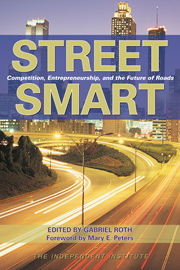Alternate versions of this article were published in the Hartford Courant, Atlanta Journal Constitution, Orlando Sentinel, and San Francisco Chronicle.
----------
One of the most consistent annoyances of living in Detroit or any other metro area is traffic. The Texas Transportation Institute’s just-released annual Urban Mobility Report ranks Detroit’s traffic again among the worst in the country—worse than Chicago, New York and Boston.
From Interstate 696 to Interstate 275 and elsewhere, lines of cars inch their way into the city and back home again or from suburb to suburb, a daily ritual that for many has become a nightmare.
Billions of dollars have been spent during the past several decades on transit subsidies, consultants, studies, special high-occupancy vehicle commuter lanes, new technologies and other hoped-for panaceas, but the congestion, delays and road rage show no sign of abating.
The bad news is: There’s no perfect solution. Too many people wanting to drive cars on the same road at the same times of day will always cause problems.
But there are ways to ease those problems.
Our road systems are like relics of the late, unlamented Soviet Union: socialist enterprises run by well-intentioned planners with no regard to the pricing and investment criteria that allocate goods and services in free societies. Moscow citizens got relief from food lines by abolishing socialism and embracing capitalism. The market economy could similarly liberate road users from excessive congestion.
If pricing is applied to the scarce resource road space, and the revenues are allowed to stimulate investment in new capacity—such as additional lanes or new technologies to speed traffic past bottlenecks—congestion could be reduced.
Road pricing is not rocket science. Thanks to recent advances in technology, road users can be charged electronically, without having to stop their vehicles, and charges can be varied from place to place and time to time as traffic conditions change.
Getting the prices right, however, is not enough. We use prices not only to restrain demand, but also to stimulate and finance needed investment. Unfortunately, some government officials and environmental activists embrace road pricing only to the extent that it will restrain the demand for road use, not to increase road capacity. They want government to spend road revenues for other purposes, particularly public transportation.
London’s Mayor Ken Livingstone, for example, introduced congestion pricing in London in 2003, but surplus revenues are being spent on mass transit. New York Mayor Michael Bloomberg advocates a similar scheme for his city. But just as sensible people do not allow alcoholics to run liquor stores, the insatiable thirst of governments for money should preclude them from involvement with road-use funds. If you want proof, look at the many ways the federal Highway Trust Fund, financed with gas taxes, has been misused.
When roads are financed solely by government, expenditures are constrained by government budgets, which continue to tighten because of the increasing burdens of social programs and skyrocketing defense spending. As a result, needed maintenance, improvements, and expansion of capacity are delayed or sidetracked, producing the kind of disaster we just witnessed in Minnesota with the collapse of the I-35 bridge.
But under private, market-based financing, expenditures would be limited only by the amounts road users are prepared to pay for better roads, not by politics. Moreover, the highest priority and most profitable projects would tend to be tackled first. Governments, on the other hand, have to spread benefits widely among constituencies, which often puts low-priority—but popular—projects on equal footing with necessary and even urgent projects.
While many will criticize road pricing and the private financing and management of roads, the question is this: Isn’t it time for a new approach?
How much worse does traffic have to get and how many more bridges have to fail before we abandon our Soviet-style approach to highway transportation and allow road users to get the roads they’re willing to pay for? When will we apply to roads the pricing and investment principles on which we rely for electricity, telecommunications, and other necessities?








